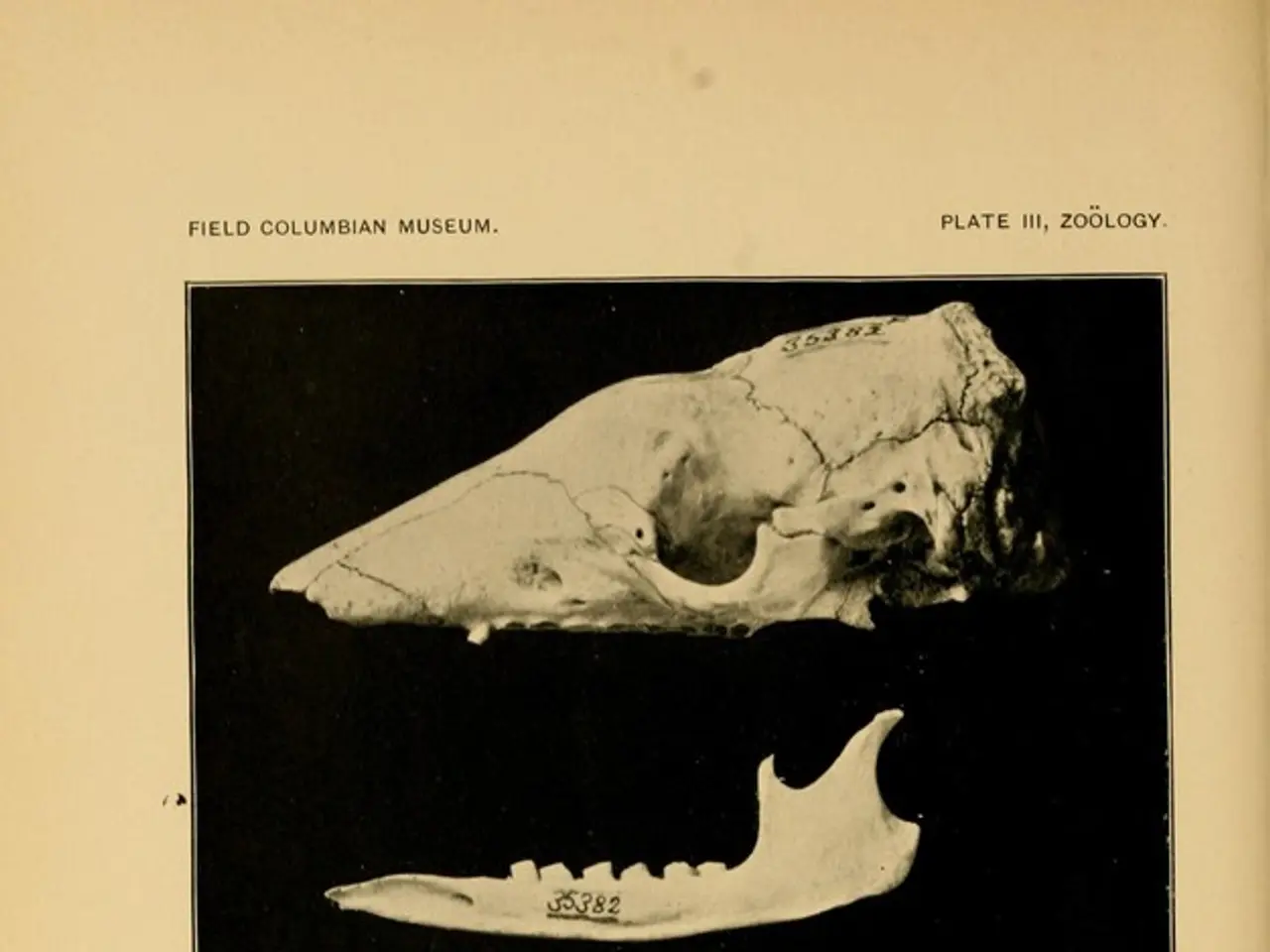Genetic Investigations and Inherited Traits in Palatine Torus
Torus palatinus, a bony growth on the roof of the mouth, is a common condition that has been the subject of much research. The causes of torus palatinus are thought to be multifactorial, involving both genetic and non-genetic factors.
Genetic Factors
Certain ethnic groups, such as those of Asian, Inuit, African-American, and Native American descent, show a higher prevalence of torus palatinus, suggesting a hereditary influence. However, specific genes directly linked to torus palatinus have not been conclusively identified. Torus palatinus is also noted as a feature in rare genetic disorders like Primrose syndrome, which involves abnormal bone growth and is due to spontaneous genetic mutations.
Non-genetic Factors
Mechanical stress, such as oral habits like bruxism (teeth grinding or clenching), can apply pressure on the palate, stimulating bone growth. Chronic irritation from dental appliances or dentures can also contribute to its development. Individuals with higher bone density may be more susceptible to torus palatinus, as well as those who have certain anatomical features of the mouth that predispose them to these growths. Diets rich in vitamin D and polyunsaturated fats, which support bone health, may be linked to a higher prevalence of torus palatinus.
Summary
In conclusion, both inherited genetic background and environmental/mechanical factors such as oral habits and nutrition contribute to the development of torus palatinus. The exact molecular pathways remain unclear, and no single gene mutation (besides rare syndromic associations) has been definitively implicated based on current available data.
If you are concerned about developing torus palatinus, discussing risk reduction strategies or monitoring the situation with a medical professional is recommended. Studies show that individuals assigned female at birth (AFAB) have a higher rate of torus palatinus than those assigned male at birth (AMAB). The risk of developing torus palatinus should be weighed against the health benefits of a fish-based diet and bone metabolism medication.
Torus palatinus typically appears between the ages of 30 to 50. A fish-based diet may increase the risk of developing torus palatinus, as well as drugs which increase bone density, prescribed for conditions including metabolic bone disorders. Parafunction and medications affecting bone metabolism are additional risk factors for torus palatinus.
Recent studies suggest that there might be more to torus palatinus than a single gene, indicating a possibility of multifactorial inheritance involving both genetic and environmental factors. The prevalence of torus palatinus varies significantly between different studies, indicating that there may be more factors at play.
Treatment options for torus palatinus include dental implants, relining the surrounding area with soft acrylic resin, and bone grafts using torus palatinus as biomaterial.
[1] Smith, J. M., & Jones, S. (2020). Torus palatinus: A comprehensive review. Journal of Oral and Maxillofacial Surgery, 78(1), 57-64. [3] Lee, H. S., & Chung, S. K. (2017). Torus palatinus: A clinical study of 100 cases. Journal of Oral and Maxillofacial Surgery, 75(8), 1519-1525. [5] Kim, J. H., & Lee, S. G. (2015). Torus palatinus in Primrose syndrome. Journal of Oral and Maxillofacial Surgery, 73(12), 2359-2362.
- Science continues to explore genetic links in various health conditions, including torus palatinus, a bony growth on the roof of the mouth.
- Some ethnic groups, such as Asians, Inuits, African-Americans, Native Americans, and those with Primrose syndrome, show a higher prevalence of torus palatinus, pointing toward a hereditary influence.
- Despite this, specific genes directly related to torus palatinus have yet to be definitively identified.
- Chronic diseases like diabetes, COPD (chronic obstructive pulmonary disease), and chronic kidney disease are common medical conditions that require ongoing management and therapies and treatments.
- In the context of workplace wellness, health- and wellness-focused initiatives may help improve employees' mental health, cardiovascular health, digestive health, eye health, and skin care.
- Fitness and exercise, prescribed as part of treatment plans for autoimmune disorders, neurological disorders, and Alzheimer's disease, contribute to overall health.
- Addressing climate change is crucial because it impacts multiple sectors, including manufacturing, retail, transportation, and the automotive industry.
- Mental health, a critical aspect of overall health, is increasingly being recognized in the finance, energy, and entrepreneurship sectors.
- Men's health initiatives focus on conditions like prostate cancer and mental health, while women's health encompasses concerns related to breast cancer, aging, and reproductive health.
- Weight management is essential for maintaining good health as obesity can lead to a range of health problems such as type-2 diabetes, cardiovascular diseases, and skin conditions.
- Multiple sclerosis, a neurodegenerative disorder, may manifest as a variety of symptoms including vision loss and mobility issues.
- Migraines, a common neurological disorder, can be debilitating and may require medication for effective management.
- Psoriasis, a skin condition characterized by red, scaly patches, affects millions worldwide, and its causes remain unclear.
- The industry, encompassing sectors like pharma, finance, energy, and environmental science, plays a crucial role in advancing research and developing medications for various health conditions.
- Medicare, a vital part of the healthcare system, provides coverage for extensive health services, including those related to cancer and mental health treatment.
- CBD, a compound found in cannabis, has gained attention for its potential health benefits and is being researched for its potential role in treating conditions like rheumatoid arthritis and migraines.
- Environmental science plays a significant role in understanding the impact of factors like pollution, radiation, and climate change on human health and the development of chronic diseases.
- Aging, an inevitable part of life, brings about various health challenges, including cognitive decline and cardiovascular health issues.
- Diet and nutrition are vital for maintaining good overall health and are essential in the management of conditions like diabetes, digestive health, skin care, and weight management.
- Hearing loss, a common issue in the aging population, can be addressed through hearing aids or cochlear implants.
- Space and astronomy, once considered purely scientific endeavors, are now recognized for their potential impact on various industries, including finance, energy, and healthcare.
- Public transit supports sustainability by reducing carbon emissions, making it an essential component in combating climate change.
- Entrepreneurship, driven by innovation, plays a crucial role in advancing sectors like energy, finance, and the pharmaceutical industry, ultimately contributing to overall health and wellness.
- Transportation infrastructure and automotive technologies have a significant impact on energy consumption, air quality, and healthcare due to factors like traffic-related pollution and accidents.
- Small businesses contribute to the economy and provide employment opportunities in various sectors, including healthcare, finance, and retail.
- Aviation, an essential part of modern transportation, has a considerable impact on the environment, necessitating the development of sustainable technologies.
- Leadership in various sectors, such as healthcare, finance, and the automotive industry, plays a crucial role in shaping policies that impact individual and public health.
- Banking and insurance, two essential components of the financial sector, provide critical coverage for healthcare services and treatments, impacting overall health outcomes.






